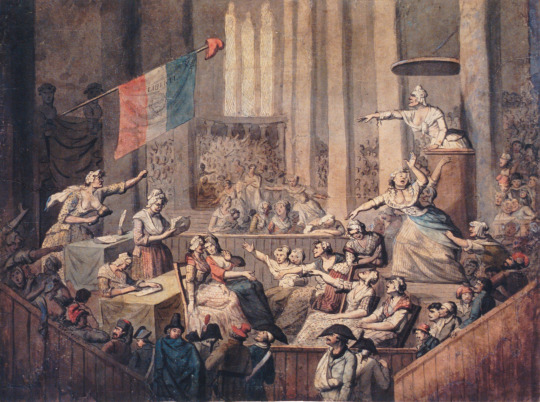Part 5: Sociétés patriotiques et Révolutionnaires: clubbist women
Although clubs had not been very common in pre-revolutionary France, political associations formed and multiplied fast after 1789. They were not only a means to gather in circles with like-minded persons or networking - important for “junior” politicians in the emerging democratic political society. They also served as arenas for debate and the exertion of influence of citizens that were still deprived of institutionalised politics: passive citizens generally, workers - and of course, women. Most political associations were men-only, but the majority of clubs allowed women in the stand, and women took advantage of this (and were noted for their presence in reports and minutes). Only about ten clubs in Paris and about 20 clubs in the provinces were mixed-gender. Women were allowed to be member, to vote and to be elected to certain offices, but never as a president. The best-known and most egalitarian mixed association was the “Société fraternelle des patriotes de l'un et l'autre sexe”, founded in 1790 and dedicated to the (political) education of the people. The fees were really small, and many of the radical democrats attended this association. Although women were not allowed to become president, the club had usually two female and two male secretaries. It is not clear, to what extend the Cordeliers can be seen as a mixed club. Women certainly had no deliberative or voting rights, but several women claimed to be “members”. Apart from that, women began to found their own all-female clubs since 1790, the most famous being the “Société patriotique et de bienfaisance des amies de la vérité”, initiated by Etta Palm in 1791, and the “Société des citoyennes républicaines révolutionnaires”, commonly dubbed “Femmes Républicaines Révolutionnaires”, in 1793. Compared to men’s clubs, there were only few women’s clubs, with relatively few members. However, some of them deployed a vast activity, challenging national politics. The most famous example for that are the Femmes Républicaines Révolutionnaires who, alongside the Enragés (Jacques Roux, Théophlie Leclerc) with whom they were linked, succeeded in pushing through many political claims and were a driving force in the petty bourgeois/sansculotte radicalisation of the Revolution (which is generally often attributed to the Jacobins who were, however, rather moderate themselves). The prohibition of female clubs in autumn 1793 needs to be interpreted in this context, for the struggle between the factions had just begun and the Convention seeked to regain the political control and thus be less vulnerable towards popular uprisings, in which radical women played a crucial role. In 1794, mixed clubs (which were, too, rather popular and more radical then the Convention wished for) were prohibited, too. But it was only in 1795, alongside the ultimate defeat of the Jacobins, that political activities of women were banned generally.
Note: There were many political clubs in the provinces in which women organised themselves. In this section, these provincial clubbists are ignored. You find them in the section on women outside Paris.

